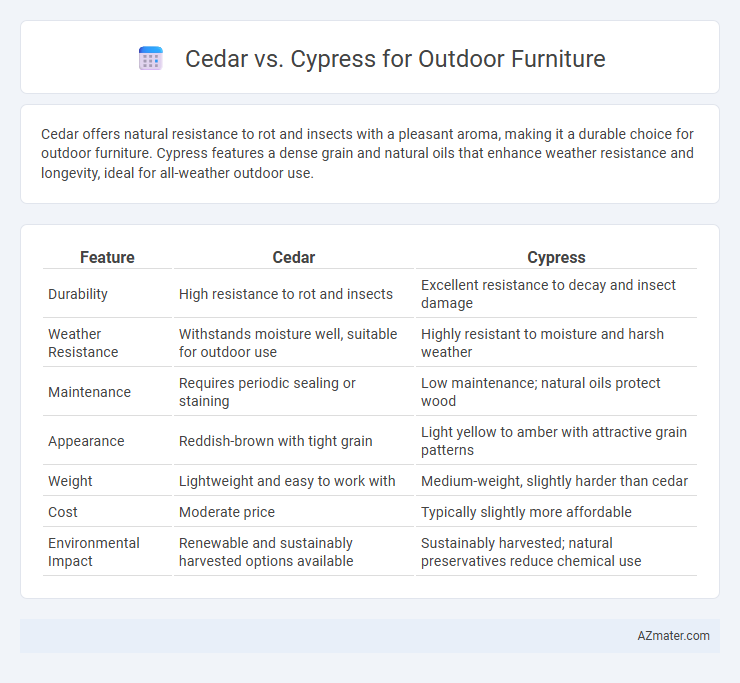Cedar offers natural resistance to rot and insects with a pleasant aroma, making it a durable choice for outdoor furniture. Cypress features a dense grain and natural oils that enhance weather resistance and longevity, ideal for all-weather outdoor use.
Table of Comparison
| Feature | Cedar | Cypress |
|---|---|---|
| Durability | High resistance to rot and insects | Excellent resistance to decay and insect damage |
| Weather Resistance | Withstands moisture well, suitable for outdoor use | Highly resistant to moisture and harsh weather |
| Maintenance | Requires periodic sealing or staining | Low maintenance; natural oils protect wood |
| Appearance | Reddish-brown with tight grain | Light yellow to amber with attractive grain patterns |
| Weight | Lightweight and easy to work with | Medium-weight, slightly harder than cedar |
| Cost | Moderate price | Typically slightly more affordable |
| Environmental Impact | Renewable and sustainably harvested options available | Sustainably harvested; natural preservatives reduce chemical use |
Introduction to Cedar and Cypress Woods
Cedar wood, known for its natural resistance to decay and insect damage, offers a rich reddish hue and aromatic qualities ideal for outdoor furniture. Cypress wood features a tight grain pattern and contains natural oils called cypressene, which provide durability and resistance to moisture and pests. Both woods are lightweight and stable, making them excellent choices for weather-resistant outdoor furnishings.
Key Differences Between Cedar and Cypress
Cedar outdoor furniture is prized for its natural resistance to rot, decay, and insect infestations, making it highly durable in various weather conditions. Cypress wood boasts a unique natural preservative called cypressene, enhancing its resistance to moisture and fungal growth, which contributes to its longevity and strength. While cedar has a richer aroma and warmer reddish hue, cypress features a lighter color with a smoother grain, influencing both aesthetic appeal and maintenance requirements.
Durability and Longevity Comparison
Cedar offers exceptional durability for outdoor furniture due to its natural resistance to rot, decay, and insect damage, making it ideal for humid or wet climates. Cypress contains natural oils called cypressene that provide strong resistance to moisture, enhancing its longevity and preventing warping or cracking over time. Both woods exhibit impressive durability, but cedar typically requires less maintenance to sustain its structural integrity and appearance in diverse environmental conditions.
Weather Resistance: Cedar vs Cypress
Cedar offers excellent weather resistance due to its natural oils that repel moisture and resist decay, making it ideal for outdoor furniture exposed to rain and humidity. Cypress contains cypressene, a natural preservative that provides strong protection against rot, insects, and fungal growth, enhancing its durability in wet and variable climates. Both woods perform well in outdoor settings, with cedar favored for its aromatic properties and cypress prized for its tighter grain and resistance to warping under fluctuating weather conditions.
Maintenance Requirements for Outdoor Use
Cedar outdoor furniture requires regular sealing or staining to maintain its natural resistance to rot and insect damage, while cypress is naturally more durable and needs less frequent treatments due to its high oil content. Both woods benefit from occasional cleaning and protection from prolonged moisture to extend their lifespan. Cypress tends to be lower maintenance overall, making it a preferred choice for outdoor furniture in humid or wet climates.
Appearance and Aesthetic Appeal
Cedar outdoor furniture showcases a rich reddish-brown hue that gracefully ages to a silvery gray, offering a warm and inviting aesthetic. Cypress features a lighter, yellowish tone with distinct grain patterns and natural knots, providing a unique rustic charm. Both woods develop a natural patina over time, enhancing the visual appeal and blending seamlessly into outdoor environments.
Cost and Availability Overview
Cedar outdoor furniture typically costs more due to its natural resistance to decay and insect damage, with prices averaging between $30 to $60 per board foot depending on the grade and origin. Cypress, often more affordable at $20 to $40 per board foot, offers good durability and availability, especially in southern U.S. markets where it grows abundantly. Both woods are widely accessible, but cedar's premium pricing reflects its longevity and aesthetic appeal, while cypress provides a budget-friendly alternative without compromising on weather resistance.
Environmental Impact and Sustainability
Cedar and cypress both offer excellent durability for outdoor furniture, but cedar has a lower environmental impact due to its faster growth rate and widespread availability, making it a more sustainable choice. Cypress is naturally resistant to decay and pests, reducing the need for chemical treatments that can harm the environment, yet it grows slower and is less abundant, which may limit sustainable sourcing. Choosing cedar from responsibly managed forests or reclaimed sources enhances sustainability by supporting carbon sequestration and reducing deforestation.
Best Uses for Each Wood Type
Cedar excels in outdoor furniture due to its natural resistance to decay, insect damage, and moisture, making it ideal for garden benches, Adirondack chairs, and picnic tables exposed to varying weather conditions. Cypress offers a tight grain and natural oils that enhance durability and prevent warping, making it perfect for intricate outdoor furniture designs like porch swings and patio sets requiring structural strength and longevity. Both woods benefit from periodic sealing to maintain appearance and extend outdoor lifespan.
Final Verdict: Which is Better for Outdoor Furniture?
Cedar is better for outdoor furniture due to its natural resistance to moisture, insects, and decay, making it highly durable in varying weather conditions. Cypress also offers good resistance but tends to be heavier and less aromatic than cedar, which some prefer for outdoor use. Overall, cedar's lighter weight, longevity, and pleasant scent make it the superior choice for outdoor furniture.

Infographic: Cedar vs Cypress for Outdoor Furniture
 azmater.com
azmater.com